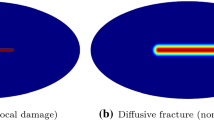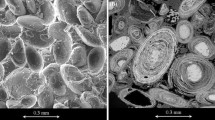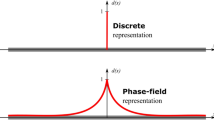Abstract
We present a formulation for mechanical modeling of the interaction between fracture and fluid flow. Our model combines the classic Biot poroelastic theory and a damage rheology model. The model provides an internally consistent framework for simulating coupled evolution of fractures and fluid flow together with gradual transition from brittle fracture to cataclastic flow in high-porosity rocks. The theoretical analysis, based on thermodynamic principles, leads to a system of coupled kinetic equations for the evolution of damage and porosity. A significant advantage of the model is the ability to reproduce the entire yield curve, including positive and negative slopes, in high-porosity rocks by a unified formulation. A transition from positive to negative values in the yield curve, referred to as a yield cap, is determined by the competition between the two thermodynamic forces associated with damage and porosity evolution. Numerical simulations of triaxial compression tests reproduce the gradual transition from localized brittle failure to distributed cataclastic flow with increasing pressure in high-porosity rocks and fit well experimentally measured yield stress for Berea sandstone samples. We modified a widely used permeability porosity relation by accounting for the effect of damage intensity on the connectivity. The new damage-permeability relation, together with the coupled kinetics of damage and porosity evolution, reproduces a wide range of realistic features of rock behavior. We constrain the model variables by comparisons of the theoretical predictions with laboratory results reporting porosity and permeability variation in rock samples during isotropic and anisotropic loading. The new damage-porosity-permeability relation enables simulation of coupled evolution of fractures and fluid flow and provides a possible explanation for permeability measurements in high-porosity rocks, referred to as the “apparent permeability paradox.”
Similar content being viewed by others
References
A. Agnon and V. Lyakhovsky, “Damage Distribution and Localization during Dyke Intrusion,” in The Physics and Chemistry of Dykes, Ed. by G. Baer and A. Heimann (Balkema, Rotterdam, 1995), pp. 65–78.
O. Allix and F. Hild, Continuum Damage Mechanics of Materials and Structures (Elsevier, Amsterdam, 2002).
A. Aydin and A. M. Johnson, “Development of Faults as Zones of Deformation Bands and as Slip Surfaces in Sandstone,” Pure Appl. Geophys. 116, 931–942 (1978).
A. Aydin and A. M. Johnson, “Analysis of Faulting in Porous Sandstones,” J. Struct. Geol. 5, 19–31 (1983).
P. Baud, W. Zhu, and T.-F. Wong, “Failure Mode and Weakening Effect of Water on Sandstone,” J. Geophys. Res. 105, 16371–16389 (2000).
Y. Bernabe and W. F. Brace, “Deformation and Fracture of Berea Sandstone,” in The Brittle-Ductile Transition in Rocks (Geophys. Monogr., 56), Ed. by A. G. Duba, W. B. Durham, J. W. Handin, and H. F. Wang (AGU, Washington, 1990), pp. 91–101.
P. Besuelle, “Compacting and Dilating Shear Bands in Porous Rock: Theoretical and Experimental Conditions,” J. Geophys. Res. 106, 13 435–13 442 (2001).
M. A. Biot, “General Theory of Three-Dimensional Consolidation,” J. Appl. Phys. 12, 155–164 (1941).
M. A. Biot, “Theory of Elasticity and Consolidation for a Porous Anisotropic Solid,” J. Appl. Phys. 26, 182–185 (1955).
M. A. Biot, “General Solutions of the Equations of Elasticity and Consolidation for a Porous Material,” J. Appl. Mech. 78, 91–96 (1956).
M. A. Biot, “Nonlinear and Semilinear Rheology of Porous Solids,” J. Geophys. Res. 78, 4924–4937 (1973).
O. Bour and P. Davy, “Connectivity of Random Fault Network Following a Power Law Fault Length Distribution,” Water Res. Res. 33, 1567–1583 (1997).
W. F. Brace, J. B. Walsh, and W. T. Frangos, “Permeability of Granite under High Pressure,” J. Geophys. Res. 73, 2225–2236 (1968).
R. M. Christensen, Mechanics of Composite Materials (Wiley-Intersci., New York, 1979).
O. Coussy, Mechanics of Porous Continua (Wiley, Chichester, 1995).
P. A. Cundall, “Numerical Experiments on Localization in Frictional Materials,” Ign. Arch. 59, 148–159 (1989).
P. A. Cundall and M. Board, “A Microcomputer Program for Modeling Large-Strain Plasticity Problems,” in Proc. 6th Int. Conf. Numerical Methods in Geomechanics, Innsbruck, Ed. by C. Swoboda (Balkema, Rotterdam, 1988), pp. 2101–2108.
C. David, T.-F. Wong, W. Zhu, and J. Zang, “Laboratory Measurements of Compaction-Induced Permeability Change in Porous Rocks: Implications for the Generation and Maintenance of Pore Pressure Excess in the Crust,” Pure Appl. Geophys. 143, 425–456 (1994).
S. R. deGroot and P. Mazur, Nonequilibrium Thermodynamics (North-Holland, Amsterdam, 1962).
E. Detournay and A. H.-D. Cheng, “Fundamentals of Poroelasticity,” in Comprehensive Rock Engineering: Principles, Practice and Projects, Vol. II: Analysis and Design Methods, Ed. by C. Fairhurst (Pergamon, 1993), pp. 113–171.
P. Dijk and B. Berkowitz, “Precipitation and Dissolution of Reactive Solutes in Fractures,” Water Res. Res. 34, 457–470 (1998).
J. Dvorkin, A. Nur, and H. Yin, “Effective Properties of Cemented Granular Materials,” Mech. Mater. 18, 351–366 (1994).
J. Dvorkin and A. Nur, “Elasticity of High-Porosity Sandstones: Theory for Two North Sea Data Sets,” Geophysics 61, 1363–1370 (1996).
I. Ekland and R. Temam, Convex Analysis and Variational Problems (Elsevier, Amsterdam, 1976).
A. C. Fowler and X. Yang, “Pressure Solution and Viscous Compaction in Sedimentary Basins,” J. Geophys. Res. 104, 12 989–12 997 (1999).
J. W. Gibbs, The Scientific Papers, Vol. 1: Thermodynamics (New York, 1961).
Y. Hamiel, V. Lyakhovsky, and A. Agnon, “Coupled Evolution of Damage and Porosity in Poroelastic Media: Theory and Applications to Deformation of Porous Rocks,” Geophys. J. Int. 156, 701–713 (2004a).
Y. Hamiel, Y. Liu, V. Lyakhovsky, et al., “A Visco-Elastic Damage Model with Applications to Stable and Unstable Fracturing,” Geophys. J. Int. 159, 1155–1165 (2004b).
Y. Hamiel, V. Lyakhovsky, and A. Agnon, “Poroelastic Damage Rheology: Dilation, Compaction, and Failure of Rocks,” Geochem. Geophys. Geosyst., No. 6, Q01008 (2005a).
Y. Hamiel, V. Lyakhovsky, and A. Agnon, “Rock Dilation, Nonlinear Deformation, and Pore Pressure Change under Shear,” Earth Planet. Sci. Lett. 237, 577–589 (2005b).
Y. Hamiel, O. Katz, V. Lyakhovsky, et al., “Stable and Unstable Damage Evolution in Rocks with Implications to Fracturing of Granite,” Geophys. J. Int. (2006) (in press).
N. R. Hansen and H. L. Schreyer, “A Thermodynamically Consistent Framework for Theories of Elastoplasticity Coupled with Damage,” Int. J. Solids Structures 31, 359–389 (1994).
N. J. Hoff, “The Necking and Rupture of Rods Subjected to Constant Tensile Loads,” J. Apl. Mech 20, 105–108 (1953).
J. A. Hudson, “The Effect of Fluid Pressure on Wave Speeds in a Cracked Solid,” Geophys. J. Int. 143, 302–310 (2000).
L. M. Kachanov, “On the Time to Rupture under Creep Conditions,” Izv. Acad. Nauk SSSR, Otdel. Tekhn. Nauk, No. 8, 26–31 (1958).
L. M. Kachanov, Introduction to Continuum Damage Mechanics (Martinus Nijhoff, 1986).
M. Kachanov, “On the Concept of Damage in Creep and in the Brittle-Elastic Range,” Int. J. Damage Mech. 3, 329–337 (1994).
D. Krajcinovic, Damage Mechanics (Elsevier, Amsterdam, 1996).
D. A. Lockner, J. D. Byerlee, V. Kuksenko, et al., “Observations of Quasi-Static Fault Growth from Acoustic Emissions,” Fault Mechanics and Transport Properties of Rocks (Int. Geophys. Series, Vol. 51), Ed. by B. Evans and T.-F. Wong (Academic, San Diego, CA, 1992), pp. 3–31.
V. A. Lyakhovsky and V. P. Myasnikov, “On the Behavior of an Elastic Cracked Solid,” Izv. Akad. Nauk SSSR, Fiz. Zemli 10, 71–75 (1984).
V. A. Lyakhovsky and V. P. Myasnikov, “On the Behavior of a Visco-Elastic Cracked Solid,” Izv. Akad. Nauk SSSR, Fiz. Zemli, No. 4, 28–35 (1985).
V. Lyakhovsky, Y. Podladchikov, and A. Poliakov, “Rheological Model of a Fractured Solid,” Tectonophysics 226, 187–198 (1993).
V. Lyakhovsky, Y. Ben-Zion, and A. Agnon, “Distributed Damage, Faulting, and Friction,” J. Geophys. Res. 102, 27 635–27 649 (1997a).
V. Lyakhovsky, Z. Reches, R. Weinberger, and T. E. Scott, “Non-Linear Elastic Behavior of Damaged Rocks,” Geophys. J. Int. 130, 157–166 (1997b).
V. Lyakhovsky, A. Ilchev, and A. Agnon, “Modeling of Damage and Instabilities of Rock Mass by Means of a Non-Linear Rheological Model,” in Dynamic Rock Mass Response to Mining (Rock Bursts and Seismicity in Mines—RaSiM5), Ed. by G. Van Aswegen, R. J. Durrheim, and W. D. Ortlepp (South African Institute of Mining and Metallurgy, Johannesburg, 2001), pp. 413–420.
V. Lyakhovsky, Y. Ben-Zion, and A. Agnon, “A Visco-Elastic Damage Rheology and Rate-and State-Dependent Friction,” Geophys. J. Int. 161, 179–190 (2005).
I. G. Main, O. Kwon, B. T. Ngwenya, and S. C. Elphick, “Fault Sealing during Deformation-Band Growth in Porous Sandstone,” Geology 28, 1131–1134 (2000).
K. Mair, I. Main, and S. Elphick, “Sequential Growth of Deformation Bands in the Laboratory,” J. Struct. Geol 22, 25–42 (2000).
L. E. Malvern, Introduction to the Mechanics of a Continuum Medium (Prentice-Hall, Englewood Cliffs, 1969).
G. Mavko and T. Mukerji, “Seismic Pore Space Compressibility and Gassmann’ls Relation,” Geophysics 60, 1743–1749 (1995).
P. Mazur, Nonequilibrium Thermodynamics (North-Holland, Amsterdam, 1962).
D. P. McKenzie, “The Generation and Compaction of Partially Molten Rock,” J. Petrol. 25, 713–765 (1984).
B. Menendez, W. Zhu, and T.-F. Wong, “Micromechanics of Brittle Faulting and Cataclastic Flow in Berea Sandstone,” J. Struct. Geol. 18, 1–16 (1996).
P. P. Mosolov and V. P. Myasnikov, “Variational Methods in Flow Theory of Visco-Plastic Media,” Appl. Math. Mech. 29, 468–492 (1965).
V. P. Myasnikov, V. A. Lyakhovsky, and Yu. Yu. Podladchikov, “Non-Local Model of Strain-Dependent Visco-Elastic Media,” Dokl. Akad. Nauk SSSR 312, 302–305 (1990).
W. I. Newman and S. L. Phoenix, “Time-Dependent Fiber Bundles with Local Load Sharing,” Phys. Rev. E 63(2) (2001).
B. T. Ngwenya, O. Kwon, S. C. Elphick, and I. G. Main, “Permeability Evolution during Progressive Development of Deformation Bands in Porous Sandstones,” J. Geophys. Res. 108(B7), 2343 (2003).
V. N. Nikolaevskii, K. S. Vasniev, A. T. Gorbunov, and G. A. Zotov, Mechanics of Saturated Porus Media (Nedra, Moscow, 1970) [in Russian].
A. Nur and J. D. Byerlee, “An Exact Effective Stress Law for Elastic Deformation of Rock with Fluids,” J. Geophy. Res. 76, 6414–6419 (1971).
M. P. Olsen, C. H. Scholz, and A. Leger, “Healing and Sealing of a Simulated Fault Gouge under Hydrothermal Conditions: Implications for Fault Healing,” J. Geophys. Res. 103, 7421–7430 (1998).
L. Onsager, “Reciprocal Relations in Irreversible Processes,” Phys. Rev. 37, 405–416 (1931).
E. Papa, “A Damage Model for Concrete Subjected to Fatigue Loading,” Eur. J. Mech., A/Solids 12, 429–440 (1993).
A. Poliakov, P. Cundall, Y. Podladchikov, and V. Lyakhovsky, “An Explicit Intertial Method for the Simulation of Viscoelastic Flow: An Evaluation of Elastic Effects on Diapiric Flow in Two-and Three-Layer Model,” in Proc. NATO Advanced Study Institute on Dynamic Modeling and Flow in the Earth and Planets, Ed. by K. E. Runcorn and D. Stone (Kluwer, Dordrecht, 1993).
I. Prigogine, Introduction to Thermodynamics of Irreversible Processes (Springfield, Ill., 1955).
Y. N. Rabotnov, A Mechanism of a Long Time Failure, in: Creep Problems in Structural Members (AN SSSR. 1959) [in Russian].
Y. N. Rabotnov, Mechanics of Deformable Solids (Nauka, Moscow, 1988) [in Russian].
C. I. Renshaw, “On the Relationship between Mechanical and Hydraulic Apertures in Rough-Walled Fractures,” J. Geophys. Res. 100, 24 629–24 636 (1995).
C. I. Renshaw, “Influence of Subcritical Fracture Growth on the Connectivity of Fracture Networks,” Water Res. Res. 32, 1519–1530 (1996).
J. R. Rice and M. P. Cleary, “Some Basic Stress Diffusion Solutions for Fluid-Saturated Elastic Porous Media with Compressible Constituents,” Rev. Geophys. Space Phys. 14, 227–241 (1976).
J. R. Rice, “Fault Stress States, Pore Pressure Distribution, and the Weakness of the San Andreas Fault,” in Fault Mechanics and Transport Properties of Rocks, Ed. by B. Evans and T. F. Wong (1992), pp. 476–503 (1992).
E. L. Robinson, “Effect of Temperature Variation on the Long-Term Rupture Strength of Steels,” Trans. Am. Soc. Mech. Eng. 174, 777–781 (1952).
A. M. Rubin, “Tensile Fracture of Rock at High Confining Pressure: Implications for Dike Propagation,” J. Geophys. Res. 98, 15 919–15 935 (1993).
L. I. Sedov, “Variational Methods of Constructing Models of Continuous Media,” in Irreversible Aspects of Continuum Mechanics (Springer, 1968), pp. 17–40.
B. Seront, T.-F. Wong, J. S. Caine, et al., “Laboratory Characterization of a Seismogenic Normal Fault System,” J. Struct. Geol. 20, 865–881 (1998).
E. Tenthorey, C. H. Scholz, E. Aharonov, and A. Leger, “Precipitation Sealing and Diagenesis 1. Experimental Results,” J. Geophys. Res. 103, 23 951–23 967 (1998).
E. Tenthorey, S. F. Cox, and H. F. Todd, “Evolution of Strength Recovery and Permeability during Fluid-Rock Reaction in Experimental Fault Zones,” Earth Planet. Sci. Lett. 206, 161–172 (2003).
D. L. Turcotte, W. I. Newman, and R. Shcherbakov, “Micro and Macroscopic Models of Rock Fracture,” Geophys. J. Int. 152, 718–728 (2003).
K. C. Valanis, “A Theory of Damage in Brittle Materials,” Eng. Fract. Mech. 36, 403–416 (1990).
T.-F. Wong and W. Zhu, “Brittle Faulting and Permeability Evolution: Hydromechanical Measurement, Microstructural Observation, and Network Modeling,” in Faults and Subsurface Fluid Flow in the Shallow Crust (Geophys. Monogr., Vol. 113), Ed. by W. C. Haneberg, P. S. Mozley, J. C. Moore, and L. B. Goodwin (AGU, Washington DC, 1999), pp. 83–99.
T.-F. Wong, C. David, and W. Zhu, “The Transition from Brittle Faulting to Cataclastic Flow in Porous Sandstones: Mechanical Deformation,” J. Geophys. Res. 102, 3009–3025 (1997).
S. Zhang, M. S. Paterson, and S. F. Cox, “Porosity and Permeability Evolution during Hot Isostatic Pressing of Calcite Aggregates,” J. Geophys. Res. 99, 15 741–15 760 (1994).
J. Zhang, T.-F. Wong, and D. M. Davies, “Micromechanics of Pressure-Induced Grain Crushing in Porous Rocks,” J. Geophys. Res. 95, 341–352 (1990).
W. Zhu, C. David, and T.-F. Wong, “Network Modeling of Permeability Evolution during Cementation and Hot Isostatic Pressing,” J. Geophys. Res. 100, 15 451–15 464 (1995).
Author information
Authors and Affiliations
Additional information
The text was submitted by the authors in English.




